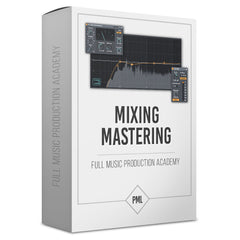
When mixing electronic music, one of the most important sounds to focus on is your kick drum. It's the heartbeat of your track. The thing that makes people dance. However, getting the right kick drum mixing results can be hard.
If you want to make bass drum magic... read on.
>> Learn how to professionally mix and master your music today! Click here.
In this article, you will learn two kick drum mixing techniques, equalization and compression. We will also include bonus tips for excellent kick drum punch and processing.
Let’s dive in.
How To EQ Your Kick Drum

Equalization is an integral part of mixing kick drums, allowing you to reduce or remove frequencies you don’t want – or increase the parts you want more of.
But it’s not as easy as throwing your equalizer on any kick drum and repeating the same process. Because each kick is different, you have to use your ears and equalize to fit your mix.
Keep this in mind when using EQ on a kick drum:
- Remove the bad
- Highlight the good
- Make it fit
With this approach in mind, you will make your kick drum the best it possibly can be while ensuring it fits with the rest of your track – especially your bass.
Let’s take a look at a kick sample in an equalizer:

As you probably know, a kick drum most often dominates the lower parts of the frequency spectrum, the left side.
But a lot of interesting things happen in the lower-mids, mid-range, and highs as well.
These frequency spectrum areas are responsible for a kick drum's other characteristics.
These are the kick drum frequencies to look for:
- 25-50 Hz: Ultra-Low Bass Rumble
- 50-80 Hz: Clearer Bass Notes
- 80-200 Hz: Punch
- 200-500 Hz: Boxiness and Muddiness
- 600 Hz-1,2 kHz: Knocking Click
- 1,2 kHz-6kHz: High Click
Practical Example
Take a look at the frequencies in this PML Ben Böhmer kick drum sample:

This kick drum sample dominates in the 48 Hz range, which equates to the note G. It’s also punchy in the 99 Hz range, also equating to a G but in one octave higher.
The frequency spectrum dips from 180 Hz, meaning little muddiness and boxy sound.
You can then see small peaks at 2.6 kHz and 4.3 kHz. These peaks are mild, giving the kick drum sample a slight clicky sound while being heavy on the low-end.
So what can we do with this kick sample?
It’s ultimately up to you and the mix.
But let’s say you want to increase the high-frequency clicks. Boost between 2.6 kHz and 4.3 kHz.
Or, you want to reduce the ultra-low booms and focus the punch higher. Notch the 50 Hz range a bit and increase in the 100 Hz range.
>> Check out the PML - Ben Böhmer Style - Melodic Deep Sound Pack

Final EQ Tips
A finished music track is rarely a kick drum and nothing else. So even though your goal should be to make your kick drum sound as good as it possibly can, you also need to consider your mix.
First of all, your kick drum should fit your track. You can determine this quite easily by testing different kick drums and play them with your other sounds.
Secondly, a kick drum’s main competitor is the bassline. So make sure that both can breathe and take up their own space.
Quick example: if your bassline frequency spectrum peaks at 80 Hz, cut the same frequency on your kick drum to let your bass breathe. The same goes the other way around.
How To Compress Your Kick Drum

Compression done the right way can make your kick drum punch harder and sound better. But it can also be more gentle and controlled.
The key to great music is dynamics. Ups and downs. And that applies to your kick drum as well. To make your kick drum better, remember that using too much compression can cause your kick drum to sound lifeless.
Keep this in mind when using a Compressor on a kick drum:
- Control the transients
- Achieve balance
- Enhance the good
Your main goal when using compression on your kicks and all other sounds is balance. Some sounds are better with more dynamic and punch. You can leave others in the backseat of your mix. With compression, you can choose to do both.
In the case of kick drum compression, you want to control the punch in the initial hit, decay, and release – and you can either go punchier or more gentle.
Control your kick drum with these four Compressor settings:
- Threshold
- Ratio
- Attack
- Release

Threshold sets when you want your compression to start working. The compression will only start working when your audio level surpasses your chosen threshold.
Ratio is the amount of compression applied. 1:00 is the lowest, and infinity is the highest – meaning completely flat.
Attack sets the time it takes for the compression to start. The longer time you use, the longer it will take. This setting is very useful when you want to retain the initial transient in kick drums.
Release is the opposite of attack time, meaning how long it takes for the compression to stop. Be careful with using very short release times because it can cause an unpleasant pumping effect.
Practical Example
Let’s take a look at the PML Ben Böhmer kick drum sample again.

The kick sample is already processed and mixed, but with a compressor, you can tailor the sound more to fit your mix.
Let’s say you want this kick sample but with smoother transients.
You can do something like this:

The ratio is high at 8:1, meaning quite a lot of compression is taking place. Attack is relatively low, which means compression will start after five milliseconds – leaving the initial click but compressing the punchier part. Release time is kept short at 20 milliseconds to make the compression re-activate quickly.
The result is a more gentle kick sample that takes up less space in your mix.
Final Compression Tips
If you want more punch in your kick – increase the attack times to leave the starting transients and reduce the ratio. Keep the release time short. These compression settings make your kick hit hard and emphasizes punch.
Find out what characteristics you want to bring out in your kick and how you want it to sound in your mix. Set your compressor accordingly.
Bonus Kick Drum Mixing Tips

We’re nearing the end of our article but still have four final tips for you. And the first is layering your kick drum to make it special.
1. Layer For Awesome Kick Drum Punch
Sometimes you find yourself with a kick that sounds great in some parts and worse in others. You might like the high-end click in one kick but not the low-end.
Do this – layer the two kicks together. Remove the high-end from your first kick and remove the low-end from your second click. Now, you have the punch from one and click from the other.
2. Sidechain
Sidechaining is great to give your kick more punch and space in your mix. You typically sidechain your kick with your bassline, so your bassline ducks every time your kick hits.
Click here to learn how to sidechain in Ableton Live.
3. Make it mono
Kicks sound better in mono. At least the lower end. For best mixing results, get a stereo widening plugin that can target specific frequencies. Then, make the kick frequencies below 100 Hz mono. The rest of the frequencies is up to you.
See here for stereo widening tips.
4. Saturate
A bit of saturation can make many sounds punchier and edgier. That also goes for your kick drums. Use a little bit of saturation if you want to increase punch. But don’t overdo it if you want your kick to sound clean.
Summary
By reading this article, you now know how you can go about mixing a kick drum. From using an EQ and shaping your kick to your desire to using powerful compression to shape your kick transients – now you can take these skills into your studio.
As a final tip, don’t be afraid to try new kick drums. Sometimes, we want a sound to fit and try all sorts of kick drum processing to make it work. But when a sample or sound is wrong, it won’t fit. Change your kick sample if you find yourself frustrated with your result.
Learn Professional Mixing And Mastering Today

Mixing and mastering are true skills that takes years of intense focus, training, and hard work to master.
Knowing what decisions to take to bring out the best in each sound while making all sounds work together is tricky.
You want to give your music that sweet signature sound and style to stand out.
But what if you could learn the exact process of what to do in different situations to achieve your desired mixing and mastering results?
Mixing and Mastering Bundle, containing five complete courses with life-time access, shows you precisely what to do.
In the complete, online courses, which includes:
- Mixing And Mastering A Melodic Techno Track (masterclass)
- How To Mix A Track With The Best Plugins Available
- Mixing A Track From Start To Finish (using stock plugins)
- Mastering From Start To Finish
Plus a complete masterclass for mixing and mastering future bass…
You will learn the complete process to mix and master your tracks, making your sounds powerful and loud, like the radio tracks.
You will also learn how to give your tracks their signature sound while keeping balance and finesse to make them sound as good as they can.
Learn The Complete Mixing And Mastering Process
And with a complete walkthrough of the most-used mixing and mastering tools and effects, like compressors, equalizers, multiband, and limiters, you will have invaluable knowledge, serving you well for the rest of your music career.
Mixing And Mastering Bundle

Thanks for reading, and see you in the next article.
 Pelle Sundin is a Swedish music producer and writer, active with his chillout project PLMTRZ. He also produces psytrance. When he's not producing, he surfs, skates, and chugs coffee. |